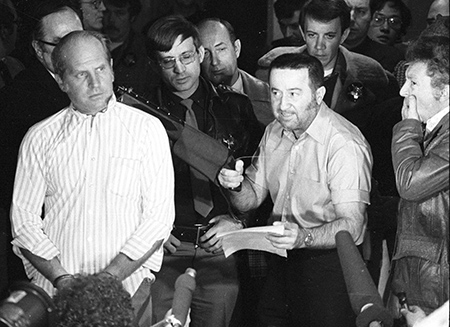Subscriber Benefit
As a subscriber you can listen to articles at work, in the car, or while you work out. Subscribe NowAnthony G. “Tony” Kiritsis woke up the morning of Feb. 8, 1977, with a plan.
It unfolded as he walked into Meridian Mortgage at 129 E. Market St. in Indianapolis. He intended to meet proprietor M.L. Hall to discuss a piece of land for which Kiritsis had fallen behind on payments.
But, M.L. wasn’t there. Instead, Kiritsis went into the office of the owner’s son, Richard O. “Dick” Hall.
Kiritsis had a .38 pistol concealed in a sling and another, more elaborate weapon hidden in a suit box. He had modified a sawed-off shotgun with a “dead man’s line” — a wire extended from the trigger to a loop, which Kiritsis placed around the younger Hall’s neck. This ensured that if law enforcement were to shoot Kiritsis during the coming stalemate, the gun pointed at Hall’s head would fire.
After exiting the building, Hall and Kiritsis — who was unable to find his vehicle — wandered first down Pennsylvania Street, and then Washington Street in full view of the public and television news cameras. When they reached Senate Avenue, Kiritsis pulled Hall into a marked police vehicle and forced him to drive to his home at Crestwood Village Apartments.
A tense, televised “press conference” was later held at the complex in which Hall was made to apologize to Kiritsis and promise him $5 million. An immunity letter (which prosecutors later admitted was a ruse) was also issued to Kiritsis. The 63-hour hostage situation — which, by that time, had captured national attention — ended peacefully when Kiritsis freed Hall and was then taken into custody.
Coinciding with the 41st anniversary of the notorious kidnapping, a new documentary, “Dead Man’s Line,” has been released by a pair of local filmmakers. The focus on the Kiritsis case also recalls how it drove change in the way the justice system treats the insanity defense.
 Berry
BerryMaking the film
The film — which won Best Feature Documentary at the 2017 East Lansing Film Festival — is available on iTunes and Amazon.
Co-director Alan Berry has lived in Indianapolis all his life and said he remembers watching the Kiritsis case unfold in real time growing up. Berry said work for “Dead Man’s Line” began five years ago and involved more than 50 interviews.
“I feel we have done a very thorough job of this story,” he said. “I am fairly proud of the product. Unless people are lying to me about it, I’ve gotten all positive reviews.”
 Enochs
EnochsCo-director Mark Enochs has worked with Berry since 2010. Enochs said he and Berry were amazed at how little primary material was available. Many of the local TV and radio stations had purged their archives. He said Jack Parker, WTTV cameraman, retrieved his tapes directly from the Dumpster.
“We ended up getting a lot of our good stuff from the actual people who had taken the footage because they usually keep copies,” he said. “We dealt with the City-County Building looking for court documents. There was very little left.”
The trial
Kiritsis’ attorneys, Nile Stanton and Richard Kiefer, were interviewed for the film, with Kiefer serving as a consultant.
 Kiefer
KieferAfter Kiritsis’ arrest, he was being held at the Marion County Jail in a cell next to Roger Drollinger, who had killed four men near Raccoon Lake in Parke County just a week after the Hall kidnapping. Kiritsis was unhappy with his lawyer at the time, and Drollinger recommended his attorney, Stanton.
Stanton said at first, Kiritsis was opposed to pleading not guilty by reason of insanity.
“He saw this as some sort of lawyer trick pulling the wool over people’s eyes,” Stanton said. “I convinced him that ‘They had it coming’ is not a defense.”
A former law school classmate of Stanton’s, Kiefer — who is now a partner at Bingham Greenebaum Doll — was invited to join as co-counsel.
 Stanton
StantonKiefer said at the time, the burden was on the prosecution to prove that the defendant was sane at the time of incident. “All we had to do was raise a reasonable doubt in the jury’s mind,” he said.
Kiefer said the best evidence of this was the well-known radio and television broadcasts. Kiritsis was convinced the Halls were trying to cheat him. Stanton said once they did their own research, they found this not to be the case.
“That even just goes to show more this guy had to be nuts to think so,” he said. “Dick Hall and his family, they were good to this guy.”
After a 14-day trial, the jury found Kiritsis not guilty by reason of insanity. Kiritsis spent years locked up on contempt of court charges because he refused further testing. He was finally released in 1988 and died in 2005.
But, at the very next session of the Indiana General Assembly after the verdict, lawmakers reacted.
 Farlow
FarlowThe aftermath
State law changed in 1978 so that anyone claiming such a defense now had the burden to prove insanity based on the preponderance of the evidence. Other high-profile cases followed, as did more changes.
Steven T. Judy was arrested in 1979 for raping and killing Terry Chasteen and murdering her three children in Mooresville. He pleaded not guilty by reason of insanity but was found guilty.
After Judy’s execution in 1981, Indiana became the second state after Michigan to adopt the standard of guilty but mentally ill. After John Hinckley Jr.’s attempted assassination of President Ronald Reagan that same year, most states either followed suit or abolished the insanity defense altogether.
 Hoffman
HoffmanFrost Brown Todd attorney Thomas Farlow was a second-year law student during the Kirtsis case and remembers “watching it like everyone else live on TV.” He then worked as a deputy prosecutor from 1978 to 1988 before turning to defense work. He said the burden of proof change was appropriate, but that the guilty but mentally ill standard was a deception.
“What it does, it creates the impression within the jurors’ minds that if they find guilty but mentally ill, that that’s really something less than guilty … when, in fact, there is no mitigation,” he said.
IU Maurer professor Joseph L. Hoffman was colleagues with one of the two lead prosecutors on the Kiritsis case, the late F. Thomas Schornhorst. Hoffman said the subsequent changes to the law meant fewer defense lawyers even tried the insanity defense any longer if they made it to trial.
 Banks
Banks“Our nation has said, ‘Yeah, wait a minute, I think we went too far in terms of saying that people who have mental illness shouldn’t be blamed for what they do,’” he said.
For about a decade, Brad Banks worked as a major felony prosecutor in Hamilton and Marion counties. For the last six years, he’s been a defense attorney. During that time, he said he barely saw such a defense used.
“I think that’s because it’s become so high-risk because they now have the guilty but mentally ill option, which is, in effect for your client, not really any better than just getting a conviction,” he said. “Supposedly, they’ll get some special consideration. … That’s not very meaningful.”•
Please enable JavaScript to view this content.

